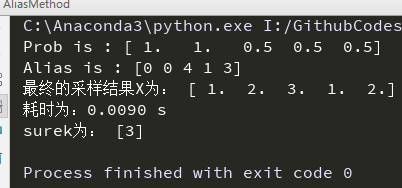【Alias Method for Sampling】原理
对于处理离散分布的随机变量的取样问题,Alias Method for Sampling 是一种很高效的方式。
在初始好之后,每次取样的复杂度为 O(1)。
、、、
【Python 代码】
# !/usr/bin/env python # encoding: utf-8 __author__ = 'ScarlettZero' # 20180522 # AliasMethod Sampling import time import numpy as np import pandas as pd import numpy.random as npr def alias_setup(probs): ''' :param probs: 某个概率分布 :return: Alias数组与Prob数组 ''' K =len(probs) # K为类别数目 Prob =np.zeros(K) # 对应Prob数组:落在原类型的概率 Alias =np.zeros(K,dtype=np.int) # 对应Alias数组:每一列第二层的类型 #Sort the data into the outcomes with probabilities #that are larger and smaller than 1/K smaller =[] # 存储比1小的列 larger =[] # 存储比1大的列 for kk,prob in enumerate(probs): Prob[kk] =K*prob # 概率(每个类别概率乘以K,使得总和为K) if Prob[kk] <1.0: # 然后分为两类:大于1的和小于1的 smaller.append(kk) else: larger.append(kk) # Loop though and create little binary mixtures that appropriately allocate # the larger outcomes over the overall uniform mixture. #通过拼凑,将各个类别都凑为1 while len(smaller) > 0 and len(larger) > 0: small = smaller.pop() large = larger.pop() Alias[small] = large #填充Alias数组 Prob[large] = Prob[large]-(1.0 - Prob[small]) #将大的分到小的上 if Prob[large] <1.0: smaller.append(large) else: larger.append(large) print("Prob is :", Prob) print("Alias is :", Alias) return Alias,Prob def alias_draw(Alias,Prob): ''' :param J: Alias数组 :param q: Prob数组 :return:一次采样结果 ''' K=len(Alias) # Draw from the overall uniform mixture. kk = int(np.floor(npr.rand()*K)) #随机取一列 # Draw from the binary mixture, either keeping the small one, or choosing the associated larger one. # 采样过程:随机取某一列k(即[1,4]的随机整数,再随机产生一个[0-1]的小数c,) # 如果Prob[kk]大于c, if npr.rand() <Prob[kk]: #比较 return kk else: return Alias[kk] if __name__ == '__main__': start=time.time() K = 5 # K初始化为5类 N = 5 # Get a random probability vector. # probs = npr.dirichlet(np.ones(K), 1).ravel() # .ravel(): 将多维数组降为一维 probs =[0.2,0.3,0.1,0.2,0.2] # Construct the table Alias, Prob = alias_setup(probs) # Prob is : [ 0.25058826 0.69258202 0.83010441 0.87901003 1. ] # Alias is : [4 4 4 4 0] ###### # Generate variates. # X 为有多少样本需要采样 X = np.zeros(N) for nn in range(N): X[nn] = alias_draw(Alias, Prob) print("最终的采样结果X为:",X) end=time.time() spend=end-start print("耗时为:%0.4f s"%spend) sure_k = np.random.choice(5, 1, p=probs) print("surek为:",sure_k) # 关于SEM的并行,我先尝试了在 sample k 的时候使用Alias Method,但是和之前比效率方面没见得有提升(之前SEM是利用 sure_k = np.random.choice(aspects_num, 1, p=p) 进行sample k的) # Alias必须是多次采样才有效率上的提升的。如果每一次sample都新来一次alias那是没有用的
运行结果:

【Reference】
2、The Alias Method: Efficient Sampling with Many Discrete Outcomes